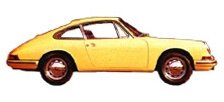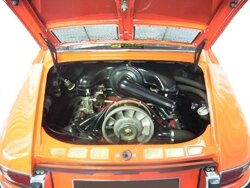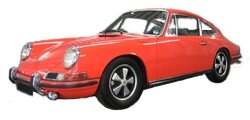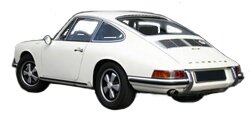Model Page
2.0 911S

|
Production Run: |
- |
|---|---|
|
Production Dates: |
1966 - 1969 |
|
Engine: |
2.0 Air Cooled Straight Six |
|
Built: |
Zuffenhausen (Germany) |
|
0-60: |
7.5 secs |
|
Max Speed: |
138 Mph |

The 2.0 911S was introduced by Porsche to give the car the power that it deserved and finally turn the vehicle into a true sports car, it was on part an admission by Porsche that the original 911 did not really have enough power to match up with its main rivals. The S or “Super” was based on the 2.0 litre six cylinder 911 the car was available between 1966 and 1969, sitting at the top of the Porsche range above the entry level 912 and 911.

Porsche 911 2.0 S
The S was fitted with the horizontally opposed, air cooled six cylinder engine taken from the standard 911 with a displacement of 1,991cc. In standard form the engine developed 130 bhp, the S featured a revised unit that developed 160 bhp @ 6,600 rpm and 132lb/ft @ 5,200 rpm. This useful boost in power was delivered through a host of changes that included larger inlet and exhaust valves these being increased in diameter by 3mm, new camshafts and revised pistons that featured raised crowns. These crowns increased the compression ratio to 9.8:1 from 9.0:1, fuelling was improved through the addition of triple barrel Weber 40IDAC3 carburettors with 30mmVenturis. A new exhaust system was fitted to improve engine breathing and the rev limiter was increased to 7,300 rpm. The “S” engine was fitted with a red cowling to identify the unit having extra potential.
The car featured the same body styling as the standard 2.0 911 but did feature some differences externally to distinguish between the S and the base models. The front and rear bumpers included a larger rubber protective edging and 15” x 4.5” wide Fuchs alloy wheels that were designed specifically for the 911 fitted with 165x15” HR tyres. Putting aside the aesthetic appeal, the wheels had other benefits saving 2.3 Kg per wheel over the steel wheels and increased wind flow to the brakes aiding cooling. Whilst the Fuchs units cost around five times as much as the steel units the benefits outweighed the costs, Porsche took the opportunity to include lightweight alloy wheel nuts at the same time.
The 911S retained its basic rear engine, rear wheel drive layout, to improve the weight distribution of the car Porsche unusually reverted to an unsophisticated solution of filling the front bumper outer extremities with 22Kg of cast Iron ballast, this gave the car a weight distribution of 41.5 / 58.5 and increased the kerb weight to 1075 Kg.

Porsche 2.0 911S
The car featured independent front suspension that was made up of MacPherson struts with Koni telescopic dampers, a 19 mm torsion bar spring and an anti-roll bar that was thicker than on the standard 911’s at 15mm. The rear suspension consisted of rear trailing wishbones with telescopic dampers and transverse 23mm torsion bar, this was the first road going Porsche to be fitted with a 16mm rear anti roll bar.
The car was the first production vehicle to be fitted with Ventilated discs all round, these being 282mm discs at the front and 290mm units at the rear. Finishing off the mechanical specification of the car was a five speed manual gearbox – no choice of gearbox was available.
The interior was upgraded, the wooden dashboard and steering wheel were removed being swapped for a padded black dashboard and a chrome and black leather steering wheel. The seats were offered in a variety of finishes these being Leather, Upholstery, Vinyl with Corduroy centres or vinyl with a hounds-tooth pattern cloth.
The car was officially introduced on October 1st 1966, the car was well received by the press with Autocar commenting on the “sparkling acceleration”. It was noted that the car was less flexible at normal speeds as the maximum torque was generated at 1,000 rpm higher than in the standard 911. A problem was identified with the installation as the spark plugs were found to foul if the car was used in a lot of city traffic, engineers advised that the car be revved above 3,000 rpm wherever possible. This aside the car did receive a significant boost in performance with 0-60 being achieved in 7.5 seconds and a top speed of 138 Mph.

Porsche 911 2.0 ltr S
The 911S was introduced as an O series car until August 1967 when the model was replaced with the 911S based on the A series 911. The A series vehicles featured a number of improvement with the chrome windscreen wipers being replaced for black items, the installation of revised door handles with recessed buttons and polished aluminium window frames. Larger door mirrors were fitted and the dials on the dash featured black bezels these replacing the earlier chrome bezels.
Each year a new series was introduced that featured minor improvements to the package, this continued through to the F series units. With the introduction of the B series units, the Fuchs wheels were decreased in size to 14”, but these were increased in width to 6” these being fitted with 185 /HR14 tyres.
In 1969 the 911S included a revised engine package, the triple barrel Weber carburettors were replaced with a Bosch mechanical fuel injection system complete with electronic ignition. These changed increased horsepower to 170 bhp @ 6,800 rpm and 135lb/ft @ 5,500 rpm. At this point the engine was fitted with a second oil cooler.
Porsche paid special attention to improving the handling characteristics of the vehicle, this was done by moving back the rear wheels 57mm, lengthening the rear trailing arms thus allowing the drive-shafts to be angled. This had the benefit of reducing the rear overhang and providing a better balanced car, twin batteries were fitted to the car – one either side positioned in the front bonnet – this all culminated in improving the overall weight distribution to 43/57.
B series cars can be identified by the vehicle being fitted with smaller horn grilles and larger indicator lenses. The front opening quarter windows were removed from the car and the rear grill on the engine cover was of a cleaner design. Interior modification included the addition of an ashtray in the centre of the dashboard, larger storage bins in the doors and a revised heating system. A smaller steering wheel was fitted and a new switch was inserted between the front seats that allowed the driver to alter the idling speed of the car.
The Facts
|
Engine: |
Porsche Air Cooled Horizontally Opposed Six Cylinder |
|---|---|
|
Capacity: |
1,991cc |
|
Valves: |
12 |
|
Compression Ratio: |
9.8:1 |
|
Fuel System: |
Pre 1969 - Triple Barrel Weber 40IDAC3 1969 On - Bosch Mechanical Fuel Injection |
|
Maximum Power: |
Pre 1969 - 160bhp @ 6,600 rpm. 1969 On - 170bhp @ 6,800 rpm |
|
Maximum Torque: |
Pre 1969 - 132lb/ft @ 5,200 rpm. 1969 On - 135 lb/ft @ 5,500 rpm |
|
Transmission: |
Manual 5 speed. |
|
Top Gear: |
- |
|
Brakes: |
Ventilated Front Discs / Ventilated Rear Discs |
|
Kerb Weight: |
1075 Kg |
|
Max Speed: |
137 Mph |
|
0-60: |
7.5 Secs |





